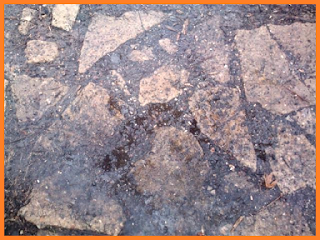For the first time in a long while, it raised to as high as 39 degrees. That's snow melting temperature! Granted, I've seen snow melt even when the temperature is as low as 28, if the sun is out and there isn't much of a breeze, but 39 is pretty much a guarantee that you'll lose some snow.
As early as 11:00 I was able to see some pretty huge effects.
I've always found melting snow to be pretty fascinating. It doesn't, after all, melt very evenly. Melting shows preference for pavement and areas in which the snow never entirely saturated an area, due to cover.
Like this drainage grate.
The temperature change due to air from within the drainage vent was so extreme that the snow this air touched melted at a faster rate than the sun touched snow above it. You can even see that ice had formed on the underside of this pile of snow.
Wow!
Obviously, you can't see the actual grate in the photo above. That's because the grate is actually a bit further back. A large air pocket formed, then was released at a weak point in the snow. This was originally a large pile of snow created when the snow plow came by. It's been reduced, literally, to a shell.
Awesome!!!
One of the things I find fascinating, and even a bit alarming, is that during cold temperatures we can see just what an effect our society has on the environment. Proof of humanity's ability to effect climate change is right in front of us, if only we allow ourselves to see what's there.
No, I'm not claiming that yesterday's melting snow had anything to do with climate change. That would be silly, because there's no way I could logically come to that conclusion. It's a single event in a single city in a single state, within a single country.
Not a whole lot to base a workable theory on!
However, we can see some evidence of society effecting the overall heat of towns and cities. This is largely due to the pavement and buildings themselves. You'll notice that snow always melts on pavement and along the sides of homes long before it melts on the dirt or grasses.
This is predominantly due to the heat generation of the man-made structures and surfaces.
They don't breathe. Formed as solid masses with no "breathing holes", these architectural creations take in, as well as generate, large amounts of heat. This is very obvious in the upper Midwest due to the melting of snow, but it's also obvious in the desert... perhaps even more so.
A person can choose to walk barefoot on the sand, but that same person's feet will burn if he or she makes the choice to step onto the pavement that's just a step away from the sand. There's a very real difference between the two surfaces. Many times, I had even chose to walk barefoot on sharp gravel, rather than dare to touch sidewalks and driveways.
Yeah... I love to walk barefoot.
I was the go-to person for information on the amount and type of stickers and thorns in a given area when I lived in the desert southwest! And I hated sidewalks for this reason.
Indeed, a larger amount of heat is generated within cities than rural areas due to the massive concentration of pavement and building structures, as well as the energy that is consumed within these environments.
This is called the urban heat island effect. NASA has a great article with video that explains it in detail.
So what can we do about it?
Are we all supposed to go move off to rural areas in order to minimize this damage? While that would be nice, it would also be ridiculous. There are small things we can do to reduce the effect of urban heat islands, though, and they don't require a tremendous amount of effort. Here are a couple.
- Planting trees to shade your home will offset large amounts of this damage, as well as help with heating costs during the summer.
- Using gravel or stones - even bricks - for your driveway surface can have a significant impact. This allows the ground to breathe, and reduces the urban heat island effect in that small area.
Last year I used flat rocks to fill an area in the driveway that had become difficult to drive over. Indeed, my husband's tires had begun to get stuck in the mud in that location. Digging into the driveway and setting flat rocks into the area enabled us to have a more stable surface to drive over. That surface was supposed to be temporary, yet it's still holding up.
Even today, with the snow continuing to melt, you can see a bit of slush on top of some of the rocks. It's the only spot on the driveway where this can be seen, too! Sure, you have to shovel snow in areas like this a bit differently than you would if the drive was filled with pavement, but it's not difficult.
We all need to do our part to keep this world beautiful for future generations. It doesn't have to be hard. Even small efforts can reap huge benefits. We just need to look around us and see what efforts can make the biggest difference. The work of a single individual can produce great rewards for society as a whole.
What other ideas can you come up with to reduce the effect of urban heat islands?
The more ideas we have, the more we can do, after all!





No comments:
Post a Comment